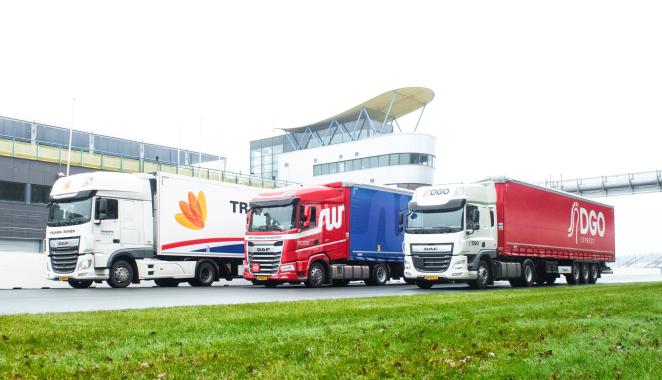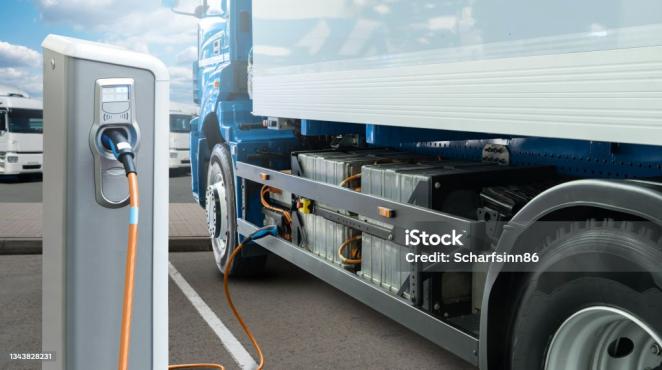On 24th June GRITH held its latest in a series of online workshops – this time around the theme of the electrification of heavy vehicles on industrial sites. The partners were joined by a large number of external stakeholders to exchange knowledge and listen to expert presentations given by guest speakers on the subject.

E-mobility hub (Sent Waninge)
The Viared case study
Lisa Govik from Chalmers University of Technology kicked off a series of three presentations with the Viared case study. The Viared port is a heavy transport hub near Gothenburg with a mix of big industry and smaller businesses. The study, undertaken on behalf of our partners at the City of Boras, aimed to explore how the incorporation of electric vehicles in operations can be organized, identifying opportunities and challenges. Currently, there is a shortage of fast public chargers. More support is needed for a public system and this will become complex unless there is consolidation and regulation.
The study in Viarad was amongst 11 public actors (including Boras) and 13 private businesses, including some logistics companies. Results on the economic aspects, organization and technological developments were highlighted for the GRITH partners.
Economic Aspects:
- Profit margins are small,
- Customers often choose cheapest not greenest
- More/less government involvement is a point of discussion.
Organization:
- Large transport hubs are the most suitable locations
- Potential impact of charging infrastructure on surroundings and congestion
- Shared charging might accelerate but is complex to organize
- Awareness of land use combinations of function.
- Charging facilities must always be available.
Technological developments:
- Most important is to expand the grid networks, every site should have charging infrastructure
- Multiple charging points to optimize charging when loading/unloading
- With simultaneous energy transition the grid is already congested -
- Technological advancements are moving fast - which way to go?
Calculating investments for the future is difficult.

Anouk Waninge at the GRITH workshop at the Climate Conference, Mechelen 2024
Sustainable business strategy
One of the stakeholders in Drenthe, and one of the frontrunners in terms of transition and e-mobility on a business site, is the Sent Waninge Group. The GRITH Online participants were treated to a very inspiring presentation by Anouk Waninge who introduced us to the past and, more importantly, the future of this successful family business. Sharing how a sustainable and future-proof business strategy is fundamental to their continued growth in the logistics sector.
Sent Waninge is based in The Netherlands, with a fleet of 150 vehicles. "The focus on sustainability is part of our company's identity and, of course, we invest a lot in this. Research has shown that electric is the best option for us at the moment. Fortunately our forward thinking meant that our request for a reinforced connection from the grid operator for 3MW was honoured - so supply is guaranteed in an otherwise congested network. Some of our clients are very excited about our emission-free transport. We're starting with three e-trucks this year," Anouk told the participants.
To charge the e-trucks, a charging area is being constructed in Hoogeveen in two phases:
1. Development of a fast-charging area - also for others as location is ideal.
2. Expansion and innovation using additional lower-powered charging station for overnight charging and investigating own energy generation in combination with a battery system.
Anouk added: “Collaboration with others is crucial. By communicating closely with local and regional authorities , we received valuable assistance and support during the transtion process.”

E-mobility in heavy transport
Electrification & innovation of logistics
As last in the lineup of presenters, Associate Professor Paul Buijs from the University of Groningen's Department of Operations, shared his expertise on the ‘Sustainable Supply Chains & Electrification of Logistics'. To set the scene he sketched the EU's sturdier plans for new trucks and CO2 emissions in the coming years. "The European Council has formally adopted the regulation on CO2 emission standards for heavy-duty vehicles to reduce CO2 emissions from road transport and have introduced new targets for the coming years. Ultimately the aim is to reduce by 90% in 2040 compared to 2019," Paul said. These more robust standards will increase the push towards zero-emission vehicles while ensuring innovation in the sector while preserving and enhancing competitiveness.
Paul continued: "Legislation, including zero-emission zoning in Dutch cities, is also a big driver and the margins are small." Although there are significant increases in e-trucks, the total numbers are still low. About 40% of the EU's total truck activity consists of trips longer than 400 km – trucks need to charge every 400 – 500 km. One innovation now being investigated is electric Roads (e-Roads). This looks similar to a train with overhead charging. Siemens has a few kms of test tracks and theoretically these e-Roads could be cost effective. The potential market has been researched in The Netherlands and efforts are now being made to connect with similar plans across the EU and to test the technology more extensively. A denser network could capture a lot of trips. Paul: "This is just one possible solution. We realize that, at the moment, battery electric trucks are the preferred option to decarbonize road freight transport, but continued research and investment in complementary technologies like e-Roads are crucial to achieving our long-term sustainability goals."
What's next?
The various presentations and different aspects of e-mobility led to dynamic discussions. Closing the session, Project Coordinator Hein Braaksma summarized: "The price of electricity and charging possibilities remains a defining factor while net congestion also hinders the current outroll of e-chargers. There’s a strong link between the energy transition and the e-mobility transition; differences in energy pricing and energy security are determinating criterion."
So what's next? Are you curious about the next GRITH Online session? We'll be back on September 5th at 14.00 CET to discuss European Legislation & CRSD. Save the Date!
